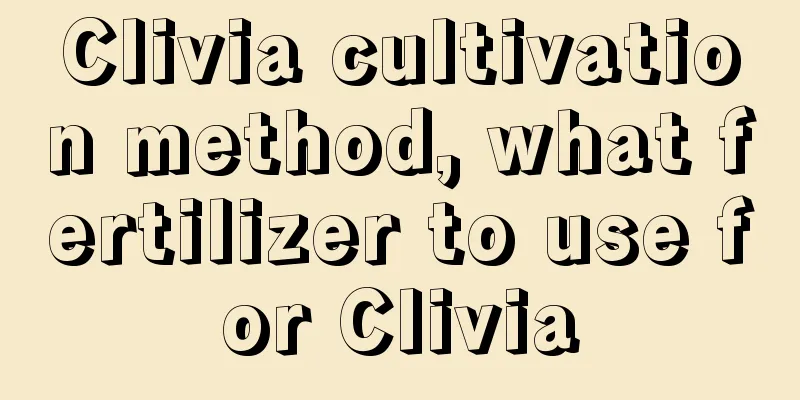What fertilizer should be used to make succulent plants grow stronger? What fertilizer is most suitable for succulent plants?

|
Succulent plants have strong adaptability to the environment and are easy to grow. But no matter what kind of plant it is, it needs to be well cared for during its growth period, especially fertilizer supplementation. For succulent plants, choose nutrient solution, organic fertilizer, slow-release fertilizer, potassium fertilizer, nitrogen fertilizer and phosphorus fertilizer. What fertilizer is good for succulent plants?1. Nutrient solution During the growth period of succulents, you can spray some nutrient solution into the soil, which can promote the rooting of succulents and promote their growth. 2. Organic fertilizer Organic fertilizer is a natural fertilizer that is pollution-free, high in nutrients, and can effectively promote the growth of succulents. Organic fertilizer is the best choice for succulents, such as chicken manure, earthworm manure, shell powder, etc. However, you should pay attention to the concentration of the fertilizer. It should not be too high, otherwise it will easily damage the roots. 3. Slow-release fertilizer The effect of applying slow-release fertilizer to succulent plants is very good. It is a special fertilizer for succulent plants, and there is no need to worry about root damage. After using slow-release fertilizer, you don’t need to apply other fertilizers for a long time. 4. Potash fertilizer Potassium fertilizer can promote the photosynthesis of succulents, and can also promote the growth of stems and roots. During the growth period of succulents, potassium fertilizer is indispensable, and potassium chloride, potassium nitrate, etc. can be used. 5. Nitrogen fertilizer Nitrogen fertilizer can make the leaves of succulent plants bigger and healthier, and can also slow down the aging of succulent plants. However, do not use too much, otherwise the plants will grow too tall. 6. Phosphate fertilizer Phosphorus fertilizer can increase the cold resistance of succulents, and it is best applied in liquid form, such as potassium dihydrogen phosphate. 7. Quick-acting fertilizer and water What is quick-acting fertilizer water? It is the quick-acting water-soluble fertilizer we know, including the compound fertilizer we know for farming at home, which is also a quick-acting water-soluble fertilizer. When we use chemical fertilizers, we must remember to apply thin fertilizers frequently and lower the concentration. After they are completely dissolved, water the succulents during the growing season. This water can be poured into the soil to supplement nutrients for the succulents. 8. General compound fertilizer Succulents can be watered with compound fertilizer . Appropriate watering of succulents with compound fertilizer can promote their rapid growth. Both the leaves and the roots can get more adequate nutrition. It can also help succulents better adapt to the scorching heat of summer and the severe cold of winter. Fertilizing succulents is generally done during the growing season. Spring and autumn are the times when they grow better, so you can apply appropriate amounts of compound fertilizer. Generally, apply compound fertilizer once every half a month to a month during the growing season. How to fertilize succulent plants1. Base fertilizer It can be understood as adding an appropriate amount of soil when mixing, such as earthworm manure, rice husk charcoal, and plant ash. The ratio does not need to be too high, 2%-5% is enough. It can be added when newly planting or changing the soil. 2. Topdressing It can be understood that you can add it whenever you want, such as slow-release fertilizer. And add some soluble fertilizers when watering, such as potassium dihydrogen phosphate. You can add some when watering, and the concentration does not need to be too high, just control it at a few ten-thousandths, or even a few hundred-thousandths. First, apply thin fertilizers frequently, and second, succulents do not need too much fertilizer. 3. Best time to apply fertilizer When fertilizing succulents, the best season should be the growing season, which is spring and autumn. At this time, regular topdressing can provide it with sufficient nutrients so that it can grow stronger. The climate and temperature in these two seasons are suitable, and succulents grow vigorously and consume more nutrients. After fertilization, they can be better absorbed, thus promoting vigorous growth. Note that you must stop fertilizing during the high and low temperatures in summer and winter, otherwise they will not be absorbed, and it is easy to cause fertilizer damage, easily burn the roots, and the plant will die. |
<<: Is it good for human health to grow orchids at home? The benefits of growing orchids indoors
Recommend
How to care for carnations
Carnation is also called the mother flower and ca...
How often should I water my Green Diamond?
How often should I water my Green Diamond? The fr...
When is the best month to prune bougainvillea? Time and method for pruning potted bougainvillea
Bougainvillea pruning time Bougainvillea needs to...
Can peonies be grown in Guangxi?
Can peonies be grown in Guangxi? As long as the r...
Is Gesang flower poisonous?
1. Contains highly toxic substances Its sap is po...
Why are orchid leaves turning yellow?
Orchids have been loved by people since ancient t...
How to make chocolate bricks explode
Key points for cultivating chocolate bricks Choco...
How to grow sugarcane to achieve high yield?
Sugarcane is not only a delicious fruit , but als...
Can red sandalwood seedlings be planted in the north?
Can red sandalwood seedlings be grown in the nort...
How to make osmanthus survive by cuttings, and what are the external conditions that affect the survival of cuttings
1. Cutting method 1. Processing of cuttings: Sele...
How to prune Schefflera arborvitae
Schefflera pruning time Because Schefflera is a f...
What to do if the Spathiphyllum flower turns green
1. Normal maintenance Cause: If the flowers of yo...
How to remedy the dryness of baby's breath, illustrated instructions for pruning baby's breath
1. How to remedy the dryness of baby's breath...
When is the best time to sow five-color chrysanthemum
Suitable time for sowing five-color chrysanthemum...
Cultivation methods and precautions of hydroponic tiger skin orchid
1. Change water on time When it comes to the issu...









